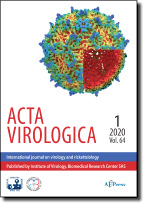Acta Virologica Vol.62, No.4, p.350-359, 2018
|
| Title: Development of a standard protocol for quantitative polymerase chain reaction to detect adenovirus 36, which is associated with obesity |
| Author: K.-A. HWANG, S. PARK, J. H. AHN, J.-H. NAM |
|
Abstract: It has been previously reported that adenovirus 36 (Ad36) infection is associated with obesity in humans and other animals. However, there is no clinically available standard protocol to detect Ad36 DNA. In this study, we developed a method for quantitative and rapid detection of Ad36 DNA. Using a TaqMan probe quantitative polymerase chain reaction (qPCR), we identified that the E3 and E4orf1 regions specifically detect Ad36 DNA, because these regions did not show cross reactivity with other types of adenoviruses. The limit of detection was 379 copy/ml and 384 copy/ml for E3 and E4orf1 regions of Ad36, respectively. The %CV (coefficient of variation) for reproducibility of the assay using adenovirus reference material ranged from 1.07–13.02. After we developed the standard protocol to detect Ad36 DNA, we used mouse as a surrogate model to confirm its clinical applicability. We administered Ad36 to mice via intranasal and oral routes, with intraperitoneal administration as the positive control, to analyze the effect of infection route. Ad36 DNA could be detected in lungs, liver, pancreas, and epididymal fat tissue after intraperitoneal injection, whereas it was found only in lungs after intranasal injection. No Ad36 DNA was detectable in any tested organ after oral injection. This indicates that the main route of infection with Ad36 is intranasal, suggesting that Ad36 is a respiratory virus. The standard protocol for qPCR developed in this study is useful for clinical detection of Ad36 DNA.
|
|
| Keywords: adenovirus 36; real-time PCR; obesity |
|
|
Published online: 23-Nov-2018
|
| Year: 2018, Volume: 62, Issue: 4 |
Page From: 350, Page To: 359 |
doi:10.4149/av_2018_402
|
|
 download file download file |
|
|
|
|
 download file
download file
